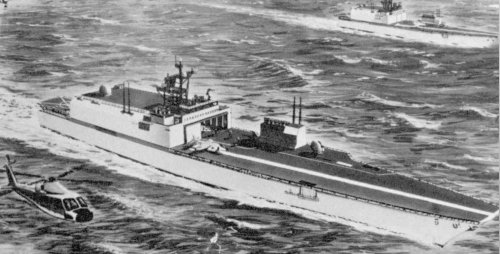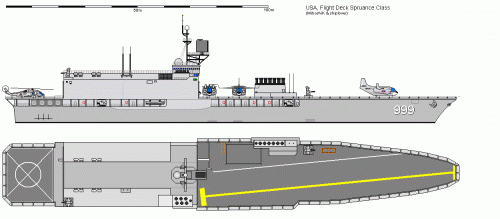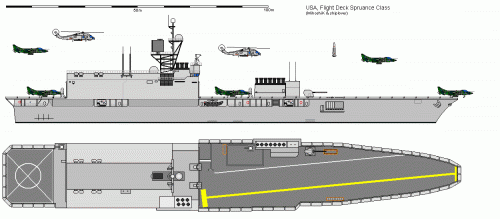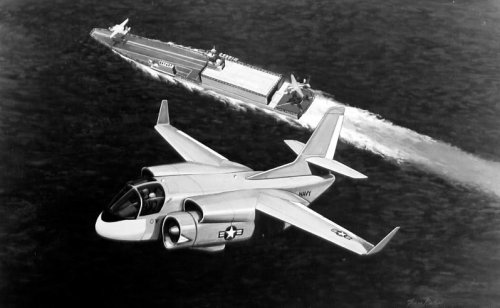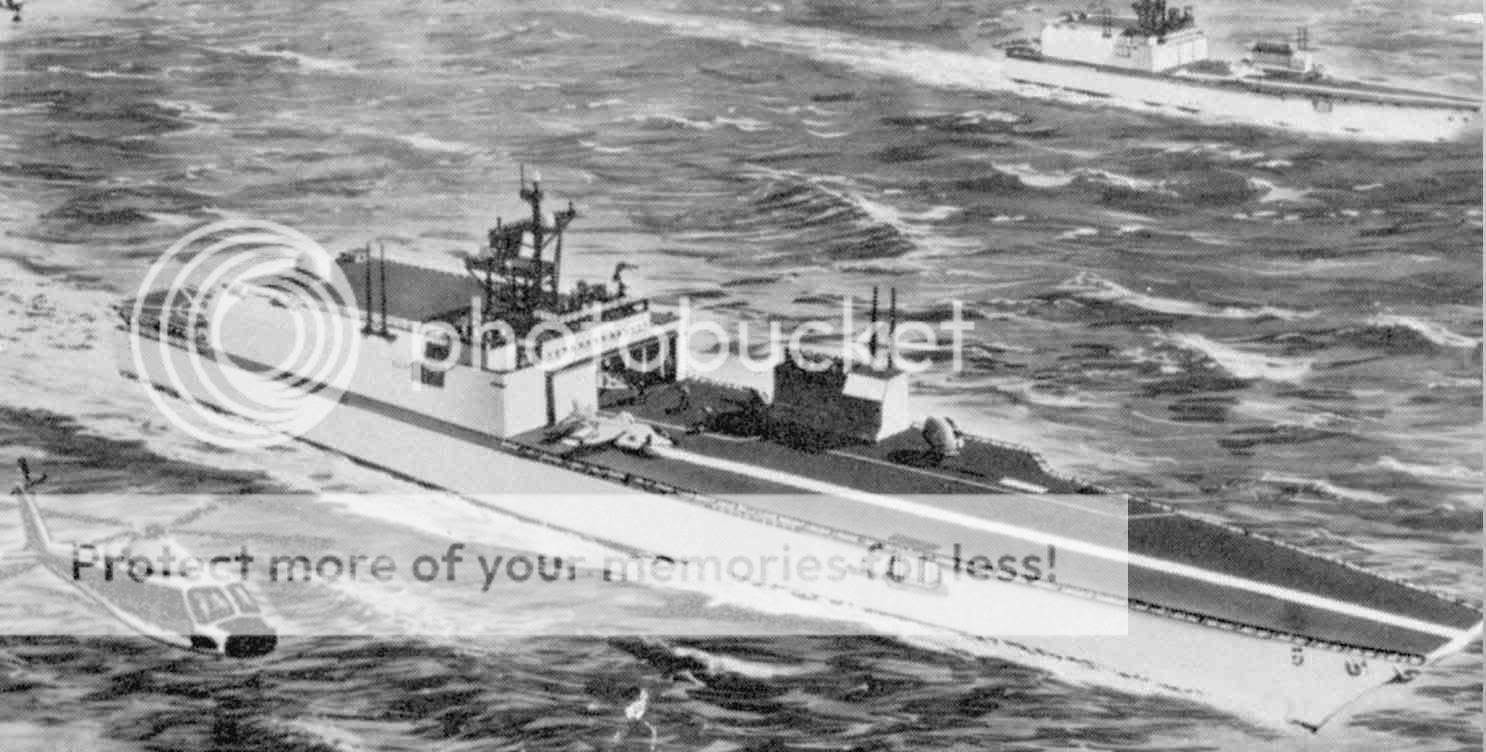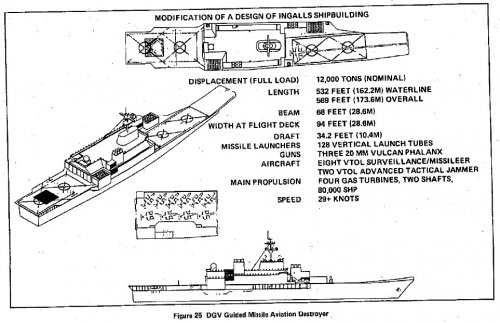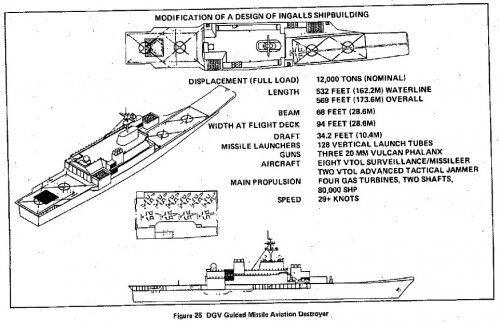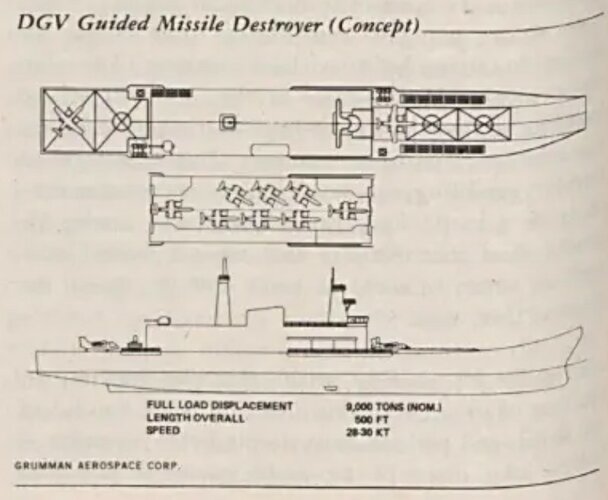You are using an out of date browser. It may not display this or other websites correctly.
You should upgrade or use an alternative browser.
You should upgrade or use an alternative browser.
Through Deck Spruance Class
- Thread starter Triton
- Start date
sferrin said:Is this real or fan art?
I presume that it is because the first painting is referenced in the article "Through Deck Cruiser - The New Capital Ship" by Michael A. Cairl
US Naval Institute Proceedings (December 1978).
The GIF images appear in the "Never Built" section of Shipbucket.
sferrin said:Is this real or fan art?
The paintings are "real," the color profiles are "fan art" of a real concept.
- Joined
- 3 June 2006
- Messages
- 3,094
- Reaction score
- 3,962
See our sister forum whatifmodelers for more color profiles! 
fightingirish said:STOVL carrier variant of Spruance class!

Source: WHAT IF MODELERS FORUM -> Hot Research Topics -> Profiles and CGI -> Spruance!
- Joined
- 9 October 2009
- Messages
- 21,973
- Reaction score
- 13,622
Great! The stuff on the Through Deck's big brother, or perhaps it may be more accurate to say it's cousin, the DGV (Guided Missile Aviation Destroyer) I found particularly fascinating. From the linked paper [with correction to one misprinted value]:
Displacement (Full Load) 12,000 Tons (Nominal)
Length 532 Feet (162.2M) Waterline
569 Feet (173.6M) Overall
Beam 68 Feet (20.7M)
Width At Flight Deck 94 Feet (28.6M)
Draft 34.2 Feet (10.4M)
Missile Launchers 128 Vertical Launch Tubes
Guns Three 20 MM Vulcan Phalanx
Aircraft Eight VTOL Surveillance/Missileer
Two VTOL Advanced Tactical Jammer
Main Propulsion Four Gas Turbines, Two Shafts,
80,000 SHP
Speed 29+ Knots
- Joined
- 26 September 2008
- Messages
- 1,960
- Reaction score
- 746
I supposed the missiles would have gone forward of the fore stacks and aft of the after stacks. But the whole design seems dubious. That's a lot of stuff to pack onto that hull. The forward stacks would also have blown a lot of fumes back on the superstructure, possibly even into the hangar.
Attachments
- Joined
- 12 July 2008
- Messages
- 394
- Reaction score
- 148
It is pretty dubious, but that paper seems more concerned with the idea of distributed air operations using its proposed plane then any specific operating platform. They point out after all that it could also operate off an FFG-7.
- Joined
- 26 September 2008
- Messages
- 1,960
- Reaction score
- 746
Sea Skimmer said:It is pretty dubious, but that paper seems more concerned with the idea of distributed air operations using its proposed plane then any specific operating platform. They point out after all that it could also operate off an FFG-7.
Yeah, and I should probably post that in a section dealing with that airplane.
There appear to be several different threads on here that refer to this modified Spruance design. I always liked the Spruances. They had a sleek hull but a boxy superstructure. But you look at this modified design and it's really hard to figure out how it could work. Imagine a light wind blowing the exhaust gasses straight at the bridge and you can see the problems.
- Joined
- 27 September 2006
- Messages
- 6,417
- Reaction score
- 6,816
The various Spruance class aviation ships are a lovely bit of 80s nostalgia. The US solved the problem by putting its Marine Harriers on the big flat top LHA/LHD ships and of course by building large CVNs in enough numbers. I did a thread on Alternate thingies which wondered what would have happened if Carter had got a second term. We might then have seen some Spruance variants perhaps?
- Joined
- 26 September 2008
- Messages
- 1,960
- Reaction score
- 746
uk 75 said:The various Spruance class aviation ships are a lovely bit of 80s nostalgia. The US solved the problem by putting its Marine Harriers on the big flat top LHA/LHD ships and of course by building large CVNs in enough numbers. I did a thread on Alternate thingies which wondered what would have happened if Carter had got a second term. We might then have seen some Spruance variants perhaps?
Elsewhere in this section is a thread on the proposed CVV, which was a conventional carrier smaller than a Nimitz, intended to take the place of the Midway. We possibly could have ended up with several of them. I just don't think the Spruance would have been modified all that much.
I like the Spruance, and there's a great book on them called Electronic Greyhounds. When they were first introduced they were criticized for being lightly armed. Later in life they were absolutely packed with weapons--lots of VLS tubes. I believe there was some discussion of equipping them to carry anti-air missiles that would be controlled by other ships like Aegis cruisers and destroyers. The idea was that a Spruance could essentially throw up a lot of additional missiles that would then be directed by these other vessels. I'm not sure that made a heck of a lot of sense, since Aegis already had a pretty high rate of fire.
- Joined
- 12 July 2008
- Messages
- 394
- Reaction score
- 148
AEGIS had a high rate of fire, but the total missile load wasn't overwhelming with the Mk26 ships that also have to support ASROC, and VLS ships would be expected to carry a fair number of Tomahawks. A lot depends on what you think SM-2 kill rates really would be, and how many Soviet naval bombers really existed. The US tended to overestimate Tu-22M production by a lot of planes. Still even one 27 plane regiment of Tu-22M with two missiles each could be ~81 max targets. Double targeting each one, provided you ambushed the Tu-22M within missile range with a missile trap, would already require far more Standard missiles then one AEGIS ship can support. Just double targeting each communist missile is 108 Standard missiles, already leaving little margin for any other weapons onboard a VLS Ticonderoga or any coverage against follow up attacks.
I don't know when work on SM-5 began exactly, I have a pdf on that somewhere at home, but I suspect the concept was a lot older then the physical work in the 1990s. A flight deck Spruance with 128 VLS cells would make a lot more sense if those VTOL aircraft could direct something like SM-5 or that early 80s ramjet SAM/SSM project against targets over the horizon. Otherwise its very hard to see what advantage such a ship would have over the Sea Control Ship which could carry as many as twenty Harrier fighters on more or less the same displacement.
I don't know when work on SM-5 began exactly, I have a pdf on that somewhere at home, but I suspect the concept was a lot older then the physical work in the 1990s. A flight deck Spruance with 128 VLS cells would make a lot more sense if those VTOL aircraft could direct something like SM-5 or that early 80s ramjet SAM/SSM project against targets over the horizon. Otherwise its very hard to see what advantage such a ship would have over the Sea Control Ship which could carry as many as twenty Harrier fighters on more or less the same displacement.
- Joined
- 16 April 2008
- Messages
- 9,605
- Reaction score
- 14,494
The idea of using aircraft as targeting assets for long-range ship-based air-defense missiles goes back to the 1970s, as part of the Battle Group Anti-Air Warfare Coordination Program, and was definitely looked at in the 1980s. That puts it right in sync with the development of these Spruance derivatives.
- Joined
- 26 September 2008
- Messages
- 1,960
- Reaction score
- 746
If you look at this image of the ship, notice the two large blocks of VLS tubes. They're pretty exposed, with their sides on the side of the ship. That doesn't seem like a good place to fit a bunch of missiles. No protection from the hull at all. Take an Exocet or a torpedo nearby and the entire magazine could go up.
Attachments
- Joined
- 3 June 2011
- Messages
- 18,335
- Reaction score
- 12,234
Sea Skimmer said:I don't know when work on SM-5 began exactly, I have a pdf on that somewhere at home, but I suspect the concept was a lot older then the physical work in the 1990s.
SM-5?
- Joined
- 12 July 2008
- Messages
- 394
- Reaction score
- 148
www.jhuapl.edu/techdigest/TD/td1804/zinger.pdf[/color]
[/color]SM-5 was a once classified program to remotely designate targets for semi active Standard Missiles. It was tested by placing some navy radar on top of a mountain in Hawaii, but ultimately not proceeded with in favor of SM-6 using an AMRAAM seeker. The reason the USN wanted this concept was that semi active guidance is much harder for the enemy to jam because of the higher power levels involved, and it offers positive control over the missile in complex air situations when friendly and neutrals mix with hostiles. Active guided missiles always present some risk that they’ll acquire the wrong target, though the two way data link on the latest AIM-120D will reduce that risk. SM-5 would also have made over the horizon anti ship attacks possible using the multi mach speed and very long range of Standard ER which is a very handy feature.
[/color]I’ve read that in the end SM-6 was said to be 80% of the capability for about half the cost, because expensive modified fighters or AEW plane with high power illuminator radar capability would not be required. It appears that both podded illuminator systems and dedicated illuminator planes were being considered. Instead SM-6 just requires some added features to the E-2D Hawkeye which was going to be built anyway, so it can supply mid course guidance commands. So that’s why SM-5 fell by the obscure wayside and SM-6 is now in production. However it does mean each SM-6 warshot costs more then an SM-5 warshot would have; but it would take a very large number of production SM-6 missiles to make up the difference in total program cost.
[/color]SM-5 was a once classified program to remotely designate targets for semi active Standard Missiles. It was tested by placing some navy radar on top of a mountain in Hawaii, but ultimately not proceeded with in favor of SM-6 using an AMRAAM seeker. The reason the USN wanted this concept was that semi active guidance is much harder for the enemy to jam because of the higher power levels involved, and it offers positive control over the missile in complex air situations when friendly and neutrals mix with hostiles. Active guided missiles always present some risk that they’ll acquire the wrong target, though the two way data link on the latest AIM-120D will reduce that risk. SM-5 would also have made over the horizon anti ship attacks possible using the multi mach speed and very long range of Standard ER which is a very handy feature.
[/color]I’ve read that in the end SM-6 was said to be 80% of the capability for about half the cost, because expensive modified fighters or AEW plane with high power illuminator radar capability would not be required. It appears that both podded illuminator systems and dedicated illuminator planes were being considered. Instead SM-6 just requires some added features to the E-2D Hawkeye which was going to be built anyway, so it can supply mid course guidance commands. So that’s why SM-5 fell by the obscure wayside and SM-6 is now in production. However it does mean each SM-6 warshot costs more then an SM-5 warshot would have; but it would take a very large number of production SM-6 missiles to make up the difference in total program cost.
Brickmuppet
ACCESS: Secret
OH!
Suddenly SM-5 puts a different perspective on things like the flight deck strike cruiser, CGV, and other similar flight deck cruiser ideas that kept cropping up from the late '70s to the mid '90s.
Suddenly SM-5 puts a different perspective on things like the flight deck strike cruiser, CGV, and other similar flight deck cruiser ideas that kept cropping up from the late '70s to the mid '90s.
- Joined
- 18 March 2008
- Messages
- 3,529
- Reaction score
- 978
SM-6 will also have the terminal illumination capability of SM-5. And not only will the AESA radar of the E-2D be able to provide such over the horizon illumination but of just about any AESA equipped aircraft. Most impressive will be the MESA radar of RAAF Wedgetails...
- Joined
- 12 July 2008
- Messages
- 394
- Reaction score
- 148
You got a source for that, because I've never once seen it so much as suggested, and it seems like an unlikely match of wavelengths. It would be very nice if its possible even if at the expense of temporarily ceasing 360 degree search.
- Joined
- 18 March 2008
- Messages
- 3,529
- Reaction score
- 978
Sea Skimmer said:You got a source for that, because I've never once seen it so much as suggested, and it seems like an unlikely match of wavelengths. It would be very nice if its possible even if at the expense of temporarily ceasing 360 degree search.
AESA radars can transmit in multiple frequencies and conduct shared functions like maintaining search and target designation. While in an E-3D it would have to stop searching half of the sky this is not such a bad thing for the few seconds needed for terminal illumination. But E-3D is only one platform that can illuminate. In a USN force Block II Super Hornets or F-35Cs (with the right software mod) could do it as well. The RAN plans on having a RAAF Wedgetail AEW&C overhead of our new AWDs that will be armed with SM-6 to provide layered over the horizon air defence.
As to the off board terminal illumination capability it has been mentioned in pretty much every brief but the first I’ve seen on the SM-6. The AMRAAM seeker is being modified considerably for this weapon. First response on Google refers to it as well if you need a source you can put in a reference.
http://www.defenseindustrydaily.com/raytheons-standard-missile-naval-defense-family-updated-02919/
- Joined
- 12 July 2008
- Messages
- 394
- Reaction score
- 148
Abraham Gubler said:
AESA radars can transmit in multiple frequencies and conduct shared functions like maintaining search and target designation.
The bandwidth of AESA is far higher then older types but this does not mean any given AESA can go from VHF to millimeter bands ect.. That’s why I’m interested in specifics, because this capability would require either several gigahertz of bandwidth or else two distinctive operating regimes.
Wedgetail uses radar based around X-band from the get go, so it’s a lot easier to understand how that would work. The USN likes its UHF search radars because they work very well in bad weather.
While in an E-3D it would have to stop searching half of the sky this is not such a bad thing for the few seconds needed for terminal illumination. But E-3D is only one platform that can illuminate. In a USN force Block II Super Hornets or F-35Cs (with the right software mod) could do it as well. The RAN plans on having a RAAF Wedgetail AEW&C overhead of our new AWDs that will be armed with SM-6 to provide layered over the horizon air defence.
As to the off board terminal illumination capability it has been mentioned in pretty much every brief but the first I’ve seen on the SM-6. The AMRAAM seeker is being modified considerably for this weapon. First response on Google refers to it as well if you need a source you can put in a reference.
http://www.defenseindustrydaily.com/raytheons-standard-missile-naval-defense-family-updated-02919/[/quote]
I’m looking at that page and they do say shipboard radars can still illuminate for semi active use, but say nothing about the E-2D having such a capability. In fact it explicitly says the active guidance would be used for terminal homing when cued by airborne platforms.
Sea Skimmer said:Double targeting each one, provided you ambushed the Tu-22M within missile range with a missile trap, would already require far more Standard missiles then one AEGIS ship can support.
Double targeting was pretty much the minimum requirement. A common procedure would be (*) to fire two missiles, wait for a hit and if no hit, fire some more. If the incoming were suspected to be nuclear-tipped, more missiles would be fired to ensure a hit before the missile came too close.
* common in the '80s at least. If the kill probability of a single missile is close enough to 1, you can avoid double-targeting, IDK if the current systems are good enough to do this.
Bgray
I really should change my personal text
- Joined
- 1 February 2012
- Messages
- 78
- Reaction score
- 24
A question-- I've noticed that many of these designs do not include a clear flight deck, having a deckhouse/hanger in the center.
Now at first glance it seems odd, since you couldn't land an aircraft if it lost its VTL capability, but on second thought, I don't know if the deck, even unobstructed would be long enough for a conventional landing. So that being said, does anyone know if it is possilbe for a harrier or an F-35 to make a conventional landing on these smaller flight decks, or for already existing ones, the decks we see on the LHA's, or does losing the ability to vertically land pretty much doom them to finding a big deck carrier or ditching?
Now at first glance it seems odd, since you couldn't land an aircraft if it lost its VTL capability, but on second thought, I don't know if the deck, even unobstructed would be long enough for a conventional landing. So that being said, does anyone know if it is possilbe for a harrier or an F-35 to make a conventional landing on these smaller flight decks, or for already existing ones, the decks we see on the LHA's, or does losing the ability to vertically land pretty much doom them to finding a big deck carrier or ditching?
- Joined
- 12 July 2008
- Messages
- 394
- Reaction score
- 148
Without an arrestor hook and wires attempting a conventional carrier landing would be a good way to slide off the far end of the deck, or worse into the island. You’d have to clear the entire deck to even try, which isn’t possible if the ship is carrying enough aircraft to need a deck park. Ditching is the only realistic option.
Physically, for AV-8B a carrier landing without wires is likely not possible. A Wasp has about 820 feet of deck. The lowest landing distance listed in the AV-8B SAC is 1,420 feet in a totally clean configuration and 90 knot stall speed. A Wasp going into a mild lets say 6 knot wind at 24 knots would cut the speed difference by ~33% roughly, but even if that reduces landing distance by 33% you still need about 950 feet of deck. I dunno if landing distance directly scales like that or not though. So maybe with a really strongwind you could land and not fall off the far end, but even then its mighty risky. Ejecting for a more certain chance of saving the pilot and protecting the ship makes more sense.
F-35B is much bigger and heavier, its likely its minimal stall speed and minimal landing distance would be considerably higher and make even a utter emergency landing that much harder to even think about.
Physically, for AV-8B a carrier landing without wires is likely not possible. A Wasp has about 820 feet of deck. The lowest landing distance listed in the AV-8B SAC is 1,420 feet in a totally clean configuration and 90 knot stall speed. A Wasp going into a mild lets say 6 knot wind at 24 knots would cut the speed difference by ~33% roughly, but even if that reduces landing distance by 33% you still need about 950 feet of deck. I dunno if landing distance directly scales like that or not though. So maybe with a really strongwind you could land and not fall off the far end, but even then its mighty risky. Ejecting for a more certain chance of saving the pilot and protecting the ship makes more sense.
F-35B is much bigger and heavier, its likely its minimal stall speed and minimal landing distance would be considerably higher and make even a utter emergency landing that much harder to even think about.
- Joined
- 3 October 2007
- Messages
- 1,960
- Reaction score
- 1,197
Sea Skimmer said:Without an arrestor hook and wires attempting a conventional carrier landing would be a good way to slide off the far end of the deck, or worse into the island. You’d have to clear the entire deck to even try, which isn’t possible if the ship is carrying enough aircraft to need a deck park. Ditching is the only realistic option.
Physically, for AV-8B a carrier landing without wires is likely not possible. A Wasp has about 820 feet of deck. The lowest landing distance listed in the AV-8B SAC is 1,420 feet in a totally clean configuration and 90 knot stall speed. A Wasp going into a mild lets say 6 knot wind at 24 knots would cut the speed difference by ~33% roughly, but even if that reduces landing distance by 33% you still need about 950 feet of deck. I dunno if landing distance directly scales like that or not though. So maybe with a really strongwind you could land and not fall off the far end, but even then its mighty risky. Ejecting for a more certain chance of saving the pilot and protecting the ship makes more sense.
F-35B is much bigger and heavier, its likely its minimal stall speed and minimal landing distance would be considerably higher and make even a utter emergency landing that much harder to even think about.
This is right. On a CV, there is at last resort the barrier which can be rigged, but they aren't going to have them on amphibs. A STOVL that loses its V/SLcapability has about the same option as a CTOL if there's no barrier: head for a shore base if possible, or eject alongside. That said, I don't think there have been that many cases where a Harrier has lost all V/SL capability, but there are numerous cases of CTOLS with hook issues. Plus, a Harrier with gear locked up probably has a better chance of coming aboard safely than a CTOL does.
Regarding stall speed, something to keep in mind: Harrier's wing is optimised for cruise, especially in the A model. Since you're going to be landing on engine thrust anyway, the lowest stall speed is not a primary concern. The F-35B, though, is a derivative of, and lighter than, the F-35A. The F-35A wing has to be concerned about the landing speed more than the Harrier's does so, and I don't know for sure, it's at least possible that although the F-35B is heavier than the Harrier, it might also have a lower wingborne stall speed. Just thinkin'.
- Joined
- 12 July 2008
- Messages
- 394
- Reaction score
- 148
Hmm yeah that could be, but the heavier weight of the F-35B is still likely to push up the distance needed to roll to a halt using the wheel brakes alone. I also just realized a really obvious problem with this... the pilot of either aircraft wont even be trained at a conventional landing. It'd be completely suicidal to have them attempt one.
Bgray
I really should change my personal text
- Joined
- 1 February 2012
- Messages
- 78
- Reaction score
- 24
Was this DGV design ever considered or is it complete fantasy?

I'm tending towards fantasy, since I haven't been able to find any other documentation about the idea for a flight deck spruance with VLS cells, but I could be wrong.

I'm tending towards fantasy, since I haven't been able to find any other documentation about the idea for a flight deck spruance with VLS cells, but I could be wrong.
kaiserd
I really should change my personal text
- Joined
- 25 October 2013
- Messages
- 1,657
- Reaction score
- 1,726
Re: Was this DGV design ever considered or is it complete fantasy?
What aircraft is it carrying? With an air-to-air missiles version? (That seems very odd/ unlikely).
Get to the root of that and it will be clearer, but seems very unlikely to be real.
Bgray said:
I'm tending towards fantasy, since I haven't been able to find any other documentation about the idea for a flight deck spruance with VLS cells, but I could be wrong.
What aircraft is it carrying? With an air-to-air missiles version? (That seems very odd/ unlikely).
Get to the root of that and it will be clearer, but seems very unlikely to be real.
- Joined
- 6 September 2006
- Messages
- 4,834
- Reaction score
- 9,457
Re: Was this DGV design ever considered or is it complete fantasy?
If you look at the actual page on Shipbucket that the image comes from you'll find a full description on the DGV design and all other designs leading to Spruance and its variants.
http://www.shipbucket.com/forums/viewtopic.php?f=13&t=4465&hilit=spruance#p98836
If you look at the actual page on Shipbucket that the image comes from you'll find a full description on the DGV design and all other designs leading to Spruance and its variants.
http://www.shipbucket.com/forums/viewtopic.php?f=13&t=4465&hilit=spruance#p98836
- Joined
- 9 October 2009
- Messages
- 21,973
- Reaction score
- 13,622
Re: Was this DGV design ever considered or is it complete fantasy?
It was also mentioned in the old Through Deck Spruance Class topic:

It was also mentioned in the old Through Deck Spruance Class topic:
http://www.secretprojects.co.uk/forum/index.php?action=dlattach;topic=6413.0;attach=149372blackstar said:Just obtained this. It is a paper on the proposed helo-carrying Spruance and the kinds of aircraft it could carry.
Grey Havoc said:Great! The stuff on the Through Deck's big brother, or perhaps it may be more accurate to say it's cousin, the DGV (Guided Missile Aviation Destroyer) I found particularly fascinating. From the linked paper [with correction to one misprinted value]:
Displacement (Full Load) 12,000 Tons (Nominal)
Length 532 Feet (162.2M) Waterline
569 Feet (173.6M) Overall
Beam 68 Feet (20.7M)
Width At Flight Deck 94 Feet (28.6M)
Draft 34.2 Feet (10.4M)
Missile Launchers 128 Vertical Launch Tubes
Guns Three 20 MM Vulcan Phalanx
Aircraft Eight VTOL Surveillance/Missileer
Two VTOL Advanced Tactical Jammer
Main Propulsion Four Gas Turbines, Two Shafts,
80,000 SHP
Speed 29+ Knots
blackstar said:I supposed the missiles would have gone forward of the fore stacks and aft of the after stacks. But the whole design seems dubious. That's a lot of stuff to pack onto that hull. The forward stacks would also have blown a lot of fumes back on the superstructure, possibly even into the hangar.
blackstar said:If you look at this image of the ship, notice the two large blocks of VLS tubes. They're pretty exposed, with their sides on the side of the ship. That doesn't seem like a good place to fit a bunch of missiles. No protection from the hull at all. Take an Exocet or a torpedo nearby and the entire magazine could go up.
- Joined
- 21 May 2006
- Messages
- 3,002
- Reaction score
- 2,278
Re: Was this DGV design ever considered or is it complete fantasy?
Excuse me Hood, but this link to Project DX, is the authors (acelanceloet) effort a real chronological development order of these ship development or fictional? I don't have much to do with Shipbucket forum!
Regards
Pioneer
Hood said:If you look at the actual page on Shipbucket that the image comes from you'll find a full description on the DGV design and all other designs leading to Spruance and its variants.
http://www.shipbucket.com/forums/viewtopic.php?f=13&t=4465&hilit=spruance#p98836
Excuse me Hood, but this link to Project DX, is the authors (acelanceloet) effort a real chronological development order of these ship development or fictional? I don't have much to do with Shipbucket forum!
Regards
Pioneer
Last edited:
- Joined
- 6 September 2006
- Messages
- 4,834
- Reaction score
- 9,457
It's a pity that Shipbucket is more well known for strange kitbashes and improbable fictional work rather than the intent to record real ships and real unbuilt designs, but that's entirely understandable!
acelanceloet's DX thread is all real designs and is there to document the DX linage in all its offshoots. He's been doing research for some time now and has made his drawings from available source drawings. Some changes may have been made in interpreting basic sketches and conflicting sources, which is unavoidable in any artists interpretation of never-built designs.
I didn't know whether you'd found his DGV image on the Shipbucket website or a google image search or a third-party site, so that's why I directed you to the original page.
acelanceloet's DX thread is all real designs and is there to document the DX linage in all its offshoots. He's been doing research for some time now and has made his drawings from available source drawings. Some changes may have been made in interpreting basic sketches and conflicting sources, which is unavoidable in any artists interpretation of never-built designs.
I didn't know whether you'd found his DGV image on the Shipbucket website or a google image search or a third-party site, so that's why I directed you to the original page.
- Joined
- 21 May 2006
- Messages
- 3,002
- Reaction score
- 2,278
Thank you Hood for the response and clarification!
My congratulations to acelanceloet for his efforts, Ive learnt a lot, and will endeavour to learn more about some of the DX designs.
Regards
Pioneer
My congratulations to acelanceloet for his efforts, Ive learnt a lot, and will endeavour to learn more about some of the DX designs.
Regards
Pioneer
- Joined
- 16 April 2008
- Messages
- 9,605
- Reaction score
- 14,494
Here is a slightly different (older) version of the Grumman DGV, from a 1980 Proceedings article (the article is about alternatives to the big-deck carriers, but doesn't really dig into DGV in any detail beyond this drawing). Sorry for the curved bow, but that's how USNI scanned it and I can't straighten it out properly.
Compared to the version above, this one is smaller (9000 tons full load and 500 ft loa vs 12000 tons and 569 ft) with only 8 aircraft in the hangar. There look to be 15 8-vell VLS modules (2 rows of 6 forward and one block of 3 in the superstructure) for a total of 120 cells (versus 128). There are two CIWS and possibly two Sea Sparrow launchers at the corners of the superstructure, as well as one 3-inch gun (because why not?). It's definitely not as polished and there's been no real effort to even sketch radars or other electronics. I suspect it's a first pass at the idea compared to the later versions with the angled TO roll and offset VLS blocks, etc.
Source: https://www.usni.org/magazines/proceedings/1980/july/nine-prejudices-about-future-naval-systems
Compared to the version above, this one is smaller (9000 tons full load and 500 ft loa vs 12000 tons and 569 ft) with only 8 aircraft in the hangar. There look to be 15 8-vell VLS modules (2 rows of 6 forward and one block of 3 in the superstructure) for a total of 120 cells (versus 128). There are two CIWS and possibly two Sea Sparrow launchers at the corners of the superstructure, as well as one 3-inch gun (because why not?). It's definitely not as polished and there's been no real effort to even sketch radars or other electronics. I suspect it's a first pass at the idea compared to the later versions with the angled TO roll and offset VLS blocks, etc.
Source: https://www.usni.org/magazines/proceedings/1980/july/nine-prejudices-about-future-naval-systems
Attachments
acelanceloet
ACCESS: Confidential
- Joined
- 21 November 2012
- Messages
- 74
- Reaction score
- 79
This is pretty interesting, as it is clearly not based on the Spruance hull and powerplant. It indeed seems an early sketch which was refined by "what if we put this on a sprucan hull" on the design we are more familiar with.
Interestingly, apart from the amount of aircraft it matches the design on the Spruance hull quite closely, 1 less module for VLS but 2 NSSM launchers and 2 phalanxes and an 76 mm vs 3 phalanxes. Both design have a launch ramp and 4 "spots" distributed 2 and 2, and both seem to have a simplified radar fit (3 "positions") So it might not be that far off in time from the other design but rather just be an alternative.....
Interestingly, apart from the amount of aircraft it matches the design on the Spruance hull quite closely, 1 less module for VLS but 2 NSSM launchers and 2 phalanxes and an 76 mm vs 3 phalanxes. Both design have a launch ramp and 4 "spots" distributed 2 and 2, and both seem to have a simplified radar fit (3 "positions") So it might not be that far off in time from the other design but rather just be an alternative.....
- Joined
- 16 April 2008
- Messages
- 9,605
- Reaction score
- 14,494
This is pretty interesting, as it is clearly not based on the Spruance hull and powerplant. It indeed seems an early sketch which was refined by "what if we put this on a sprucan hull" on the design we are more familiar with.
Interestingly, apart from the amount of aircraft it matches the design on the Spruance hull quite closely, 1 less module for VLS but 2 NSSM launchers and 2 phalanxes and an 76 mm vs 3 phalanxes. Both design have a launch ramp and 4 "spots" distributed 2 and 2, and both seem to have a simplified radar fit (3 "positions") So it might not be that far off in time from the other design but rather just be an alternative.....
Good point. I had not looked closely, but there are some major differences, like the presence of fin stabilizers. And It looks like it must have quite a different machinery arrangement to trunk all the uptakes together in one relatively small stack.
- Joined
- 16 April 2008
- Messages
- 9,605
- Reaction score
- 14,494
Just wanted to call out that this version, with only limited missile capacity, seems to predate the DGV version with 120+ VLS cells. I have the Litton preliminary design study from June 1977, which I need to figure out how to scan properly. It has a few minor differences from the versions in these Shipbucket sketches.
acelanceloet
ACCESS: Confidential
- Joined
- 21 November 2012
- Messages
- 74
- Reaction score
- 79
The amount of power is likely about the same in my estimation, as a slightly smaller hull that goes slightly slower is exactly what I would expect of that. But yeah, the Spruance machinery arrangement would not work with that uptake and superstructure arrangement. I do wonder if it would use gas turbines at all, although the uptake seems to be about the same size as the 2 funnels of the Spruance combined.
I think the Spruance-based DGV also had active stabilisation. The DGV hull apparently was lengthened to allow for that without too many issues (which also increased displacement to the 12k tons)
That preliminary design study is the Adams and Rains design I suppose? This shipbucket drawing might match a tad better maybe (access to sources has improved over the years) or is it still very different? http://cizadlo.us/JScholtens/Public/Project DX/DDH Adams and Rains Through Deck Spruance.png
I think the Spruance-based DGV also had active stabilisation. The DGV hull apparently was lengthened to allow for that without too many issues (which also increased displacement to the 12k tons)
That preliminary design study is the Adams and Rains design I suppose? This shipbucket drawing might match a tad better maybe (access to sources has improved over the years) or is it still very different? http://cizadlo.us/JScholtens/Public/Project DX/DDH Adams and Rains Through Deck Spruance.png
Similar threads
-
-
-
-
Commander Ghiradella's Air-Capable Spruance
- Started by Triton
- Replies: 3
-

